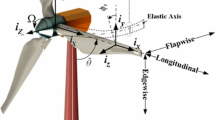Abstract
In light of the characteristics of the interactions between flexible structure and wind in three directions, and based on the rational mechanical section-model of structure, a new aerodynamic force model is accepted, i. e. the coefficients of three component forces are the functions of the instantaneous attack angle and rotational speed Ci = Ci(β(t), Θ), (i = D, L, M). So, a new method to formulate the linear and nonlinear aerodynamic items of wind and structure interacting has been put forward in accordance with “strip theory” and modified “quasi-static theory”, and then the linear and nonlinear coupled theory of super-slender structure for civil engineering analyzing are converged in one model. For the linear aerodynamic-force parts, the semi-analytical expressions of the items so-called “flutter derivatives” corresponding to the one in the classic equations have been given here, and so have the nonlinear parts. The study of the stability of nonlinear aerodynamic-coupled torsional vibration of the old Tacoma bridge shows that the form and results of the nonlinear control equation in rotational direction are in agreement with that of V. F. Böhm's.
Similar content being viewed by others
References
Scanlan R H, Tomko J J. Airfoil and bridge deck flutter derivatives [J]. J Eng Mech, ASCE, 1971,97(EM6):1717–1737.
Scanlan R H. The action of flexible bridges under wind (I) flutter theory [J]. J Sound Vibration, 1978,60(2):187–199.
Lin Y K. Motion of suspension bridges in turbulent winds [J]. J Eng Mech, ASCE,1979,105(EM6): 921–923.
Lin Y K, Ariaratnam S T. Stability of bridge motion in turbulent winds [J]. J Struct Mech,1980, 8(1):1–15.
Scanlan R H. The action of flexible bridge under wind (II) buffeting theory [J]. J Sound Vibration, 1978,60(2):201–211.
Davenport A G. The response of slender, line-like structures to a gusty wind [J]. Proceedings ICE,1962,23:389–407.
Scanlan R H. Interpreting aeroelastic models of cable-stayed bridges [J]. J Eng Mech, ASCE, 1987,113(4):555–575.
Sarkar P P, et al. Identification of aeroelastic parameters of flexible bridges [J]. J Eng Mech, ASCE, 1994,120(8):1718–1742.
Piccardo G. A methodology for the study of coupled aeroelastic phenomena [J]. J Wind Eng Indus Aerodynamic, 1993,48:241–252.
Solari G. Gust-Excited Vibrations [M]. New York: Springer-Verlag, 1994.
Strømmen E, Hiorth-Hansen E. The buffeting wind loading of structural members at an arbitrary attitude in the flow [J]. J Wind Eng Indus Aerodynamic,1995,56:267–290.
Brito J L V, Riera J D. Aerodynamic instability of cylindrical bluff bodies in non-homogeneous flow [J]. J Wind Eng Indus Aerodynamic,1995,57,81–96.
Parkinson G V, Brooks N P H. On the aeroelastic instability of bluff cylinders [J]. J Appl Mech, 1961,83:250–258.
Novak M. Aeroelastic galloping of rigid and elastic bodies [R]. Univ Western Ontorio, London/Canada, Res Rep BLWT–3–68,1968.
Böhm V F. Berechnugn nichtlinearer aerodynamisch erregter schwingungen von Hangebrucken [J]. Der Stahlbau,1967,7:207–215.
Falco M, Curami A, Zasso A. Nonlinear effects in sectional model aeroelastic parameters [J]. J Wind Eng Indus Aerodynamic, 1992,41–44:1321–1332.
Diana G, Cheli F, Resta F. Time domain aeroelastic force identification on bridge decks [A]. In: 9th International Conference of Wind Engineering [C]. New Delhi, India, 1995,938–949.
Borri C, Höffer R, Zahlten W. A nonlinear approach for evaluating simultaneous buffeting and aeroelastic effects on bridge decks [A]. In: 9th International Conference of Wind Engineering [C]. New Delhi, India, 1995, 839–850.
Steinmann D G, Hangebrücken-Das aerodynamische problem und seine lösung [J]. Acier-Steel-Stahl, 1954,19(10–11):495,542.
Scanlan R H, Jones N P, Singh L. Inter-relation among flutter derivatives [J]. J Wind Eng Indus Aerodynamic, 1997,69–71:829–837.
XU Xu, CAO Zhi-yuan. New expressions of nonlinear aerodynamic forces in civil engineering [A]. In: Proceedings of the 3rd Int Conf on Nonlinear Mech(ICNM-III) [C]. Shanghai University Press Shanghai, Aug, 1998, 396–401.
XU Xu, CAO Zhi-yuan. Stability analysis of nonlinear aerodynamic-coupled torsional vibration [J]. Journal of Nonlinear Dynamics in Science and Technology, 1999, 6 3: 228–234. (in Chinese)
Author information
Authors and Affiliations
Rights and permissions
About this article
Cite this article
Xu, X., Cao, Zy. Linear and Nonlinear Aerodynamic Theory of Interaction between Flexible Long Structure and Wind. Applied Mathematics and Mechanics 22, 1446–1457 (2001). https://doi.org/10.1023/A:1022895028953
Issue Date:
DOI: https://doi.org/10.1023/A:1022895028953



